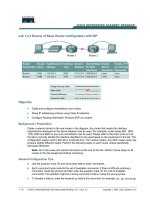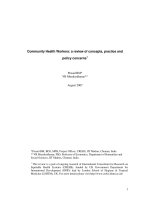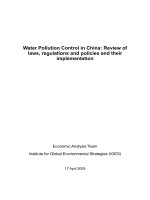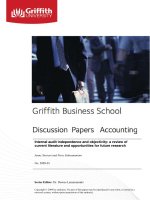Module 3 - Review of OSPF Fundamentals and Features potx
Bạn đang xem bản rút gọn của tài liệu. Xem và tải ngay bản đầy đủ của tài liệu tại đây (666.48 KB, 31 trang )
© 2008 Cisco Systems, Inc. All rights reserved. Cisco ConfidentialBSCI
1
BSCI Module 3 Lesson 1 - Review of OSPF
Fundamentals and Features
OSPF
© 2008 Cisco Systems, Inc. All rights reserved.BSCI
2
CCNP – BSCI Bachkhoa Networking Academy
Học viện mạng Bách Khoa - www.bkacad.com
Objective
Link-State Routing Protocols
Overview of OSPF Operations
OSPF Data Structures
OSPF Adjacency Database
OSPF Area Structure
OSPF Router Types
OSPF Terminology
Calculation the OSPF Metric
Link-State Data Structure
© 2008 Cisco Systems, Inc. All rights reserved.BSCI
3
CCNP – BSCI Bachkhoa Networking Academy
Học viện mạng Bách Khoa - www.bkacad.com
Link-State Protocols
Each router has a full picture of the network topology,
including bandwidth information for links to remote
networks. Therefore, each router is able to
independently select a loop-free and efficient pathway,
based on cost, to reach every network in the area.
OSPF is a classless routing protocol
Support VLSM
Support Discontigous
© 2008 Cisco Systems, Inc. All rights reserved.BSCI
4
CCNP – BSCI Bachkhoa Networking Academy
Học viện mạng Bach Khoa - Website: www.bkacad.com
4
Link-State Routing
Routers with link-state routing protocols use a Hello protocol
to discover any neighbors on its links. A neighbor is any
other router that is enabled with the same link-state routing
protocol.
© 2008 Cisco Systems, Inc. All rights reserved.BSCI
5
CCNP – BSCI Bachkhoa Networking Academy
Học viện mạng Bach Khoa - Website: www.bkacad.com
5
Sending Hello Packets to Neighbors
Connected interfaces that are using
the same link state routing protocols
will exchange hello packets.
Once routers learn it has neighbors
they form an adjacency
–2 adjacent neighbors will
exchange hello packets.
–These packets will serve as a
keep alive function.
Link-State Routing
© 2008 Cisco Systems, Inc. All rights reserved.BSCI
6
CCNP – BSCI Bachkhoa Networking Academy
Học viện mạng Bach Khoa - Website: www.bkacad.com
6
Link-State Routing
Building the
Link State Packet
Each router builds its
own Link State Packet
(LSP)
Contents of LSP:
–State of each
directly connected
link
–Includes
information about
neighbors such as
neighbor ID, link
type, & bandwidth.
© 2008 Cisco Systems, Inc. All rights reserved.BSCI
7
CCNP – BSCI Bachkhoa Networking Academy
Học viện mạng Bach Khoa - Website: www.bkacad.com
7
Directly Connected Networks.
Link: this is an interface on a router.
Link state: this is the information about the state of the links.
Link-State Routing
© 2008 Cisco Systems, Inc. All rights reserved.BSCI
8
CCNP – BSCI Bachkhoa Networking Academy
Học viện mạng Bach Khoa - Website: www.bkacad.com
8
Link-State Routing
Flooding LSPs to Neighbors
Once LSP are created they are forwarded out to neighbors.
–After receiving the LSP the neighbor continues to forward it
throughout routing area.
© 2008 Cisco Systems, Inc. All rights reserved.BSCI
9
CCNP – BSCI Bachkhoa Networking Academy
Học viện mạng Bach Khoa - Website: www.bkacad.com
9
Link-State Routing
© 2008 Cisco Systems, Inc. All rights reserved.BSCI
10
CCNP – BSCI Bachkhoa Networking Academy
Học viện mạng Bach Khoa - Website: www.bkacad.com
10
Link-State Routing
Determining the shortest
path
–The shortest path to a
destination determined by
adding the costs & finding
the lowest cost.
© 2008 Cisco Systems, Inc. All rights reserved.BSCI
11
CCNP – BSCI Bachkhoa Networking Academy
Học viện mạng Bach Khoa - Website: www.bkacad.com
11
Link-State Routing
Once the SPF algorithm has
determined the shortest path
routes, these routes are
placed in the routing table.
© 2008 Cisco Systems, Inc. All rights reserved.BSCI
12
CCNP – BSCI Bachkhoa Networking Academy
Học viện mạng Bách Khoa - www.bkacad.com
Metrics and Routing Protocols
The Metric Parameters
Different routing protocols use different metrics. Two different routing
protocols might choose different paths to the same destination due to
using different metrics.
Metrics used in IP routing protocols include:Hop count, Bandwidth, Load,
Delay, Reliability, Cost
RIP
OSPF
© 2008 Cisco Systems, Inc. All rights reserved.BSCI
13
CCNP – BSCI Bachkhoa Networking Academy
Học viện mạng Bách Khoa - www.bkacad.com
Overview of OSPF Operations
Link-state routing protocols have
the following characteristics:
–Respond quickly to network changes
–Send triggered updates when a
network change occurs
–Send periodic updates, known as
link-state refresh, at long intervals,
such as every 30 minutes
LSAs are reliable (ACK)
LSAs have a sequence number
LSAs are propagated to all
neighboring devices using the
reserved class D multicast
address 224.0.0.5.
© 2008 Cisco Systems, Inc. All rights reserved.BSCI
14
CCNP – BSCI Bachkhoa Networking Academy
Học viện mạng Bách Khoa - www.bkacad.com
OSPF Data Structures
–Neighbor table:
•Also known as the adjacency database
•Contains list of recognized neighbors
–Topology table:
•Typically referred to as LSDB
•Contains all routers and their attached links in the area or
network
•Identical LSDB for all routers within an area
–Routing table:
•Commonly named a forwarding database
•Contains list of best paths to destinations
© 2008 Cisco Systems, Inc. All rights reserved.BSCI
15
CCNP – BSCI Bachkhoa Networking Academy
Học viện mạng Bách Khoa - www.bkacad.com
OSPF Adjacency Database
–Routers discover neighbors by exchanging hello packets
224.0.0.5
–Routers declare neighbors to be up after checking
certain parameters or options in the hello packet.
© 2008 Cisco Systems, Inc. All rights reserved.BSCI
16
CCNP – BSCI Bachkhoa Networking Academy
Học viện mạng Bách Khoa - www.bkacad.com
Forming OSPF Adjacencies
–Point-to-point WAN links:
•Both neighbors become fully adjacent.
–LAN links:
•Neighbors form a full adjacency with the DR and BDR.
•Routers maintain two-way state with the other routers
(DROTHERs).
–Routing updates and topology information are passed only
between adjacent routers.
–Once an adjacency is formed, LSDBs are synchronized by
exchanging LSAs.
–LSAs are flooded reliably throughout the area (or network).
© 2008 Cisco Systems, Inc. All rights reserved.BSCI
17
CCNP – BSCI Bachkhoa Networking Academy
Học viện mạng Bách Khoa - www.bkacad.com
OSPF Area Structure
To reduce the SPF calculations, link-state routing
protocols can partition networks into sub-domains
called areas.
An area is a logical collection of OSPF networks,
routers, and links that have the same area
identification.
© 2008 Cisco Systems, Inc. All rights reserved.BSCI
18
CCNP – BSCI Bachkhoa Networking Academy
Học viện mạng Bách Khoa - www.bkacad.com
OSPF area
characteristics:
• Minimizes routing
table entries
• Localizes impact of
a topology change
within an area
• Detailed LSA
flooding stops at
the area boundary
• Requires a
hierarchical
network design
OSPF Area Structure
© 2008 Cisco Systems, Inc. All rights reserved.BSCI
19
CCNP – BSCI Bachkhoa Networking Academy
Học viện mạng Bách Khoa - www.bkacad.com
OSPF Router Types
© 2008 Cisco Systems, Inc. All rights reserved.BSCI
20
CCNP – BSCI Bachkhoa Networking Academy
Học viện mạng Bách Khoa - www.bkacad.com
• Routers A and B are
backbone routers.
• Backbone routers
make up area 0.
• Routers C, D, and E are
known as area border
routers (ABRs).
• ABRs attach all other
areas to area 0.
Area Terminology
© 2008 Cisco Systems, Inc. All rights reserved.BSCI
21
CCNP – BSCI Bachkhoa Networking Academy
Học viện mạng Bách Khoa - www.bkacad.com
OSPF Terminology
© 2008 Cisco Systems, Inc. All rights reserved.BSCI
22
CCNP – BSCI Bachkhoa Networking Academy
Học viện mạng Bách Khoa - www.bkacad.com
OSPF Calculation
Routers find the best paths to destinations by applying
Dijkstra’s SPF algorithm to the link-state database as
follows:
–Every router in an area has the identical
link-state database.
–Each router in the area places itself into
the root of the tree that is built.
–The best path is calculated with respect to the
lowest total cost of links to a specific destination.
–Best routes are put into the forwarding database (routing
table).
© 2008 Cisco Systems, Inc. All rights reserved.BSCI
23
CCNP – BSCI Bachkhoa Networking Academy
Học viện mạng Bách Khoa - www.bkacad.com
SPF Calculation
Assume all links are Ethernet, with an OSPF cost of 10.
© 2008 Cisco Systems, Inc. All rights reserved.BSCI
24
CCNP – BSCI Bachkhoa Networking Academy
Học viện mạng Bách Khoa - www.bkacad.com
Link-State Data Structures: LSA
Operation
© 2008 Cisco Systems, Inc. All rights reserved.BSCI
25
CCNP – BSCI Bachkhoa Networking Academy
Học viện mạng Bách Khoa - www.bkacad.com
Activity
3.1.2 Check Box: RIPv1 versus OSPF
–Upon completion of this activity, the student will be able to
compare routing issues between RIPv1 and OSPF.
3.1.6 Drag and Drop: OSPF Router Types
–Upon completion of this activity, the student will be able to
identify the four different types of OSPF routers.









